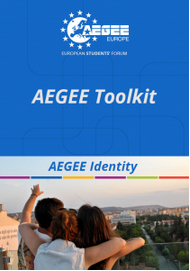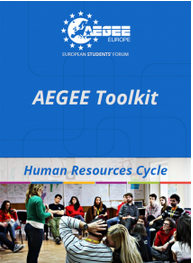Pick a topic; any topic, occupation, skill or subject and you will find a multitude of how-to guides in stores or online. Grossing over 1800 guides the For Dummies guides might be the very first of these to come to mind. However, until recently there wasn’t a guide yet that could tell you how to deal with the various aspects any member of AEGEE might encounter during his or her membership.
Go online, then go to the Members Portal and you will find a collection of eight, of which three still upcoming, how-to manuals, which are called toolkits. As the name suggests, these toolkits could prove to be very convenient whenever in a stressful situation. After all, a helpful tool could already do half the work for anyone.
Back to our past
 The first of the five already published toolkits is on the most fundamental of mankind’s philosophical questions and rightwing parties’ most vocally expressed standpoint: Identity. Much like the Bohemian artists in Baz Luhrmann’s Moulin Rouge the identity of AEGEE and its members could be summed up in four pillars; vision, mission, means and statement of principles. While they might not seem as interesting to a reader as the exclamations of ‘beauty’, ‘truth’, ‘freedom’ and ‘love’, these four pillars do contain a bit of those four bohemian ones in them. Vision is to strive for a democratic, diverse, borderless and integrated Europe, in which there is an esteemed place for young people’s participation. It is in short, an aspiration of the generally youthful members of AEGEE for all to be able to enjoy and shape the different cultural flavours, which are in such a rich abundance on the European continent.
The first of the five already published toolkits is on the most fundamental of mankind’s philosophical questions and rightwing parties’ most vocally expressed standpoint: Identity. Much like the Bohemian artists in Baz Luhrmann’s Moulin Rouge the identity of AEGEE and its members could be summed up in four pillars; vision, mission, means and statement of principles. While they might not seem as interesting to a reader as the exclamations of ‘beauty’, ‘truth’, ‘freedom’ and ‘love’, these four pillars do contain a bit of those four bohemian ones in them. Vision is to strive for a democratic, diverse, borderless and integrated Europe, in which there is an esteemed place for young people’s participation. It is in short, an aspiration of the generally youthful members of AEGEE for all to be able to enjoy and shape the different cultural flavours, which are in such a rich abundance on the European continent.
How to achieve this mission? Every European themed activity attended by every member of AEGEE had in fact paved the way for this vision. The international themes of these activities were not merely a decoration, but to either a greater or lesser extend something that made members more aware of the interconnections of the various cultures and likeminded communities throughout Europe. This in its proper terms gets summed up in the statement of principles, using keywords to describe the vision, mission and means: diversity, cooperation, freedom, a strong Europe and progress.
 As any child is formed by his or her upbringing from an early age onward, a community is also defined by its history. Generally a student association’s history goes as far back as its longest existing member, except for AEGEE. Using the History Toolkit any member can dig up some fun facts about their association using the smart timeline. AEGEE for instance is not very old, however, it does exist longer than the age of most of its individual members. It has been established even before the fall of the Berlin Wall, in the middle of the nineteen eighties at the height of the Reganite anti-communist offense during the Cold War.
As any child is formed by his or her upbringing from an early age onward, a community is also defined by its history. Generally a student association’s history goes as far back as its longest existing member, except for AEGEE. Using the History Toolkit any member can dig up some fun facts about their association using the smart timeline. AEGEE for instance is not very old, however, it does exist longer than the age of most of its individual members. It has been established even before the fall of the Berlin Wall, in the middle of the nineteen eighties at the height of the Reganite anti-communist offense during the Cold War.
In 1985 EGEE, as it was called then, was founded in Paris by representatives from six cities from each a different country. Although it was inspired by an earlier 1950’s student protest for a more integrated Europe in Strasbourg, the name was based on neither its foundation nor its inspiration. The name EGEE (États Généraux des Étudiants de l’Europe) is in fact an onomatopoeia of the Aegean, a sea whose costal shores are one of the contenders for the oldest democratic political system on earth. More specifically the Greek colony of Patras on the north-western most part of the Peloponnesos. Furthermore, the choice of referring to itself as an ‘États Généraux’ or an Estates General is a conscious one. In many European countries the Estates General or the ‘Commons’ is a political body where representatives who are not of nobility or clergy can take a seat in. Like the Estates General, AEGEE consists of common members representing the general population of their respective country or antenna or to put it differently, direct democratic representation: no elitism. To cut a long story short, next time someone says he or she is a member of AEGEE they are referring to an organisation, which values both proponents of classical and modern democracy.
 Fundraising, Public Relations and Human Resources Cycle
Fundraising, Public Relations and Human Resources Cycle
Fundraising manual is a helpful tool, which shows that fundraising can occur in a number of ways. From public to private funding of either money or goods, it shows that fundraising thrives on a mutual gain. How do you get these mutually beneficial donations? Check out the toolkit. So next time, when an antenna organizes a barbecue, there might be a chance that the meat is free and fresh, funded from the local butcher.
When members go on a Summer University they might have noticed that in their home country AEGEE is viewed as an association, whereas abroad it is a forum or a union. As languages differ, so do the concepts their words try to articulate. So, when something is called an ‘association’ in French the word ‘forum’ might cover the concept of AEGEE best in English. Spanning thirty-five languages, there is a name for AEGEE in each and every one of them. For more interesting notes on how to promote an antenna, check out the Public Relations toolkit.
 Finally there is the Human Resources Cycle, which could be seen as the Book of the Living combined with the Book of the Dead, but AEGEE style. From a member’s introduction to their entry into alumni-hood, there is one manual to help them all the way. This guide could be seen as the mother of all toolkits, since it combines bits of all the other published toolkits. It has parts of the four pillars of AEGEE, to which each member is subtlety introduced to from their introduction onwards. It shows how to promote AEGEE and deals a bit with AEGEE’s history and its fundraising. However, above all it gives aspiring mentors some convenient tips on how to excel at an introduction. Being a mentor or parent is never easy and sometimes people might wish there was a guide. However, as an aspiring mentor of an introduction, how could you resist a toolkit that refers to you as “angels”?
Finally there is the Human Resources Cycle, which could be seen as the Book of the Living combined with the Book of the Dead, but AEGEE style. From a member’s introduction to their entry into alumni-hood, there is one manual to help them all the way. This guide could be seen as the mother of all toolkits, since it combines bits of all the other published toolkits. It has parts of the four pillars of AEGEE, to which each member is subtlety introduced to from their introduction onwards. It shows how to promote AEGEE and deals a bit with AEGEE’s history and its fundraising. However, above all it gives aspiring mentors some convenient tips on how to excel at an introduction. Being a mentor or parent is never easy and sometimes people might wish there was a guide. However, as an aspiring mentor of an introduction, how could you resist a toolkit that refers to you as “angels”?
Written by Willem Laurentzen, AEGEE-Nijmegen

